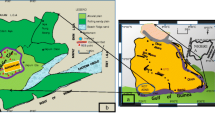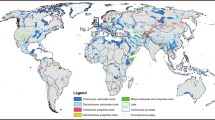Abstract
We used borehole-constrained geophysical measurements and laboratory analyses of water samples and hydrogeological unit samples to estimate the basic petrophysical parameters required in the Kozeny-Carman-Bear’s equation. This led to the estimation of hydraulic conductivity, permeability and tortuosity. The evaluation of hydraulic pressure gradient differential and the hydraulic pressure differential was possible through Darcy’s law. Our main objective was to assess the effect of hydraulic pressure gradient differential and that of the hydraulic pressure differential on the hydrodynamic coefficients of economically hydrogeologic units of the study area. The specific constants of water such as density, dynamic viscosity and acceleration due to gravity were all employed in estimating some of the parameters as required in the empirical relations used. Graphical relations were used to predict the generic behaviour between permeability and its dependence, and hydraulic pressure gradient and hydraulic pressure differentials respectively. The results of our analyses show that in arenaceous hydrogeologic units like sands characterised by interconnected/communicating pores, hydraulic pressure differential will be high as the thickness of the saturated unit increases—the precondition for high hydrodynamic activity in the saturated medium. Again, in argillaceous materials, the hydraulic pressure gradient differential is high as it is caused by poor geofluid thickness penetration due to little or no communication between pores. This reduces the hydrodynamic coefficients like porosity and permeability in such hydrogeologic units. The observation of these hydraulic energy parameters in hydrogeologic units could be the physical basis for predicting groundwater flow and a guide to designing geofluid flow modelling programmes in saturated subsurface.














Similar content being viewed by others
References
Adelinet M, Fortin J, d’Ozouville N, Violette S (2008) The relationship between hydrodynamic properties and weathering of soils derived from volcanic rocks, Galapagos Islands (Ecuador). Environ Geol 56(1):45–53
Akpan AE, Ugbaja AN, George NJ (2013) Integrated geophysical, geochemical and hydrogeological investigation of shallow groundwater resources in parts of the Ikom-Mamfe embayment and the adjoining areas in Cross River State. Nigeria Environ Earth Sci 70(3):1435–1456. doi:10.1007/s12665-0132232-3
Akpan AE, George NJ, George AM (2009) Geophysical investigation of some prominent gully erosion sites in Calabar, south-eastern Nigeria and its implications to hazard prevention. Disaster Adv 2(3):46–50
American Petroleum Institute (API). 1960 Recommended practice for core analysis procedure. Report No. 40. pp 55
Batayneh AT (2009) A hydrogeophysical model of the relationship between geoelectric and hydraulic parameters, Central Jordan. J Water Resour Prot 1:400–407. doi:10.4236/jwarp.2009.16048
Benson PM, Meredith PG, Schubnel A (2006) Role of void space geometry in permeability evolution in crustal rocks at elevated pressure. J Geophys Res Solid Earth (1978–2012) 111:B12
Bernabé Y, Bruderer C (1998) Effect of the variance of pore size distribution on the transport properties of heterogeneous networks. J Geophys Res Solid Earth (1978–2012 103:B1
Bernabé Y, Zamora M, Maineult A, Li M, Tang YB (2011) Pore connectivity, permeability, and electrical formation factor: a new model and comparison to experimental data. J Geophys Res Solid Earth (1978–2012) 116:B11
Bernabé Y, Li M, Maineult A (2010) Permeability and pore connectivity: a new model based on network simulations. J Geophys Res Solid Earth (1978–2012) 115:B10
Bhattacharya, P.K., Patra, H.P. 1968 Direct current geoelectric sounding: principles and interpretation: . Elsevier
Börner F, Schopper JR, Weller A (1996) Evaluation of transport and storage properties in the soil and groundwater zone from induced polarization measurements. Geophys Prospect 44:583–611
Chakravarthi V, Shankar GBK, Muralidharan D, Harinarayana T, Sundararajan N (2007) An integrated geophysical approach for imaging subbasalt sedimentary basins: case study of Jam River Basin, India. Geophysics 72(6):B141–B147. doi:10.1190/1.2777004
Coelho D, Thovert JF, Adler PM (1997) Geometrical and transport properties of random packings of spheres and aspherical particles. Phys Rev E 55(2):1959–1962
David C (1993) Geometry of flow paths for fluid transport in rocks. J Geophys Res Solid Earth (1978–2012) 98:B7
Edet AE, Worden RH (2009) Monitoring of the physical parameters and evaluation of the chemical composition of river groundwater in Calabar (southern eastern Nigeria). Environ Monit Assess 157:243–258
Emerson DW (1969) Laboratory electrical resistivity measurements of rocks. Proc Aust Inst Min Metall 230:51–62
Evans J, Cade C, Bryant S (1997a) A geological approach to permeability prediction in clastic reservoirs. In: Kupecz JA, Gluyas J, Bloch (eds) Reservoir quality prediction in sandstones and carbonates: AAPG Memoir, vol 69, pp. 91–101
Evans JP, Forster CB, Goddard JV (1997b) Permeability of fault-related rocks and implications for hydraulic structure of fault zones. J Struct Geol 19:1393–1404
Evans UF, George NJ, Akpan AE, Obot IB, Ikot AN ( 2010) A study of superficial sediments and aquifers in parts of Uyo local government area, Akwa Ibom State, Southern Nigeria, using electrical sounding method. E-J Chem 7(3):1018–1022
Fetters CW (1994) Applied hydrogeology, third edn. Prentice Hall Inc, Englewood Cliffs, p. 600
Galehouse JS (1971) Sedimentation analysis. In: RF C (ed) Procedures in sedimentary petrology. Wiley, New York, p. 653
Gavrilenko P, Gueguen Y (1989) Pressure dependence of permeability: a model for cracked rocks. Geophys J Int 98:1–18
George NJ, Akpan AE, Obot IB (2010) Resistivity study of shallow aquifer in parts of southern Ukanafun local government area, Akwa Ibom State. E-J Chem 7(3):693–700
George NJ, Akpan AO, Umoh AA (2013) Preliminary geophysical investigation to delineate the groundwater conductive zones in the coastal region of Akwa Ibom State, Southern Nigeria, around the Gulf of Guinea. Int J Geosci 4:108–115. doi:10.4236/ijg.2013.41011
George NJ, Ekong UN, Etuk SE (2014a) Assessment of economically accessible groundwater reserve and its protective capacity in eastern Obolo local government area of Akwa Ibom State, Nigeria, using electrical resistivity method. International Journal of Geophysics; Hindawi Publishing Company 2014:1–10. doi:10.1155/2014/578981
George NJ, Emah JB, Ekong UN (2015a) Geohydrodynamic properties of hydrogeological units in parts of Niger Delta, southern Nigeria. J Afr Earth Sci 105:55–63. doi:10.1016/j.jafrearsci.2015.02.009
George NJ, Ibanga JI, Ubom AI (2015b) Geoelectrohydrogeological indices of evidence of ingress of saline water into freshwater in parts of coastal aquifers of Ikot Abasi, southern Nigeria. J. Afri Earth Sci. 109:37–46. doi:10.1016/j.jafrearsci.2015.05.001
George NJ, Obianwu VI, Obot IB (2011) Estimation of groundwater reserve in unconfined frequently exploited depth of aquifer using a combined surficial geophysical and laboratory techniques in the Niger Delta, Southern Nigeria. Adv Appl Sci Res Pelegia Res Library 2(1):163–177
George NJ, Ubom AI, Ibanga JI (2014b) Integrated approach to investigate the effect of leachate on groundwater around the Ikot Ekpene Dumpsite in Akwa Ibom State, South-eastern Nigeria. Int J Geophys, Hindawi Publ Company 2014:1–10. doi:10.1155/2014/174589
Gowd SS (2004) Electrical resistivity surveys to delineate groundwater potential aquifers in Peddavanka watershed, Anantapur District, Andhra Pradesh, India. Environ Geol 46:118–131. doi:10.1007/s00254-004-1023-2
Griggs J (2004): A re-evaluation of geopressured-geothermal aquifers as an energy resouRce. MSc thesis submitted to the Department of Petroleum, Graduate Faculty of the Louisiana State University
Gurunadha Rao VVS, Tamma Rao G, Surinaidu L, Rajesh R, Mahesh J (2011) Geophysical and geochemical approach for seawater intrusion assessment in the Godavari delta basin, A.P., India. Water, Air Soil Pollut 217:503–514. doi:10.1007/s11270-010-0604-9
Ibuot JC, Akpabio GT, George NJ (2013) A survey of the repository of groundwater potential and distribution using geoelectrical resistivity method in Itu local government area (L.G.A), Akwa Ibom State, southern Nigeria. Central Eur J Geosci 5(4):538–547. doi:10.2478/s13533-012-0152-5
Jones PH (1969) Hydrodynamics of geopressure in the Northern Gulf of Mexico Basin. J Pet Technol 1969:803–810
Khabbazi AE, Ellis JS, Bazylak A (2013) Developing a new form of the Kozeny–Carman parameter for structured porous media through lattice-Boltzmann modelling. Comput Fluids 75:35–52
Milsch H, Blöcher G, Engelmann S (2008) The relationship between hydraulic and electrical transport properties in sandstones: an experimental evaluation of several scaling models. Earth Planet Sci Lett 275(3–4):355–373
Okazaki K, Noda H, Uehara S, Shimamoto T (2014) Permeability, porosity and pore geometry evolution during compaction of Neogene sedimentary rocks. J Struct Geol 62:1–12
Orellana E, Mooney AM (1966) Master curve and tables for vertical electrical sounding over layered structures. InteRciencia, Escuela
Papathanassiou AN (1997) Contribution of the pressure variation of the porosity to the activation volume evaluation from ionic conductivity measurements under pressure. J Phys Chem Solids 58(12):2107–2119
Reijers TJA, Petters SW (1987) Depositional environment and diagenesis of Albian carbonates in Calabar Flank S E Nigeria. J Pet Geol 10:283–294
Reijers TJA, Petters SW, Nwajide CS (1997) The Niger delta basin. In: Selley RC (ed) African basins-sedimentary basin of the world, vol 3. Elsevier Science, Amsterdam, pp. 151–172
Roy KK, Elliot HM (1981) Some observations regarding depth of exploration in DC electrical methods. Geoexploration 19:1–13
Sabet MA (1975) Vertical electrical resistivity sounding locate groundwater resources: a feasibility study. Virginia Polytechnical Institute, Water Resources Bulletin 73:63 pp
Shu-Qing Y, Lim SY (1999) Closure to mechanism of energy transportation and turbulent flow in a 3-D channel. Journal of Hydraulic Engineering ASCE 125(3):319–320
Singh SB, Veeraiah B, Dhar RL, Prakash BA, Rani MT (2011) Deep resistivity sounding studies for probing deep fresh aquifers in the coastal area of Orissa, India. Hydrogeol J 19:355–366
Singh KP (2005) Nonlinear estimation of aquifer parameters from surficial resistivity measurements. J Hydrol Earth Syst Sci Discuss 2:917–938 SRef-ID: 1812-2116/hessd/2005-2-917
Slater L (2007) Near surface electrical characterization of hydraulic conductivity: from petrophysical properties to aquifer geometries—a review. Surv Geophys 28:169–197. doi:10.1007/s10712-007-9022-y
Thompson AH, Katz AJ, Krohn CE (1987) The microgeometry and transport properties of sedimentary rock. Adv Phys 36(5):625–634
Van Overmeeren R (1989) Aquifer boundaries explored by geoelectrical measurements in the coastal plain of Yemen: a case study of equivalence. Geophysics 54:38–48
Vender Velpen, B.P.A., 1988 A computer processing package for D.C. Resistivity interpretation for IBM compatibles, ITC J 4, The Netherlands
Walsh JB, Brace WF (1984) The effect of pressure on porosity and the transport of rock. J Geophys Res 89:9425–9431
Weimin X, Caichu X, Wang W, Yuewei B (2013) Combined effect of tortuosity and surface roughness on estimation of flow rate through a single rough joint. J Geophys Eng 10(4):045015
Xu, C., Heidari, Z. and Torres-Verdin, C. (2012) Rock classification in carbonate reservoirs based on static and dynamic petrophysical properties estimated from conventional well logs: SPE annual technical conference and exhibition, SPE 159991
Xu C, Terres-Verdin C, Shuang G (2013) Interpretation of hydraulic rock types with resistivity logs in tertiary deepwater turbidite reservoirs: pore-scale modelling verified with field observations in the Gulf of Mexico, USA. Technical paper, Interpretation 1(2):T177–T185. doi:10.1190/INT-2013-00837.1
Zhang S, Tullis TE, Scruggs VJ (1999) Permeability anisotropy and pressure dependency of permeability in experimentally sheared gouge materials. J Struct Geol 21(7):795–804
Zohdy A. A. R, Eaton G.P. and Mabey, D.R. 1974 Application of surface geophysics to groundwater investigation. USGS techniques of water resources investigations. Book 2, Chapter D1
Zohdy AAR (1965) The auxiliary point method of electrical sounding interpretation and its relationship to the Dar-Zarrouk parameters. Geophysics 30:644–660
Acknowledgments
We are grateful to Millennium Development Goal Initiative for sponsoring and providing the first author with the water and cored geological samples that were used in the study. Indeed, we are grateful to University of Calabar, Cross River State, Nigeria, for providing the major and auxiliary equipments and their accessories used in acquiring and processing the field and the laboratory data. The managing editor and the anonymous reviewers are acknowledged for their intellectual contributions, which improve the quality of the manuscript.
Author information
Authors and Affiliations
Corresponding author
Rights and permissions
About this article
Cite this article
George, N.J., Akpan, A.E. & Evans, U.F. Prediction of geohydraulic pore pressure gradient differentials for hydrodynamic assessment of hydrogeological units using geophysical and laboratory techniques: a case study of the coastal sector of Akwa Ibom State, Southern Nigeria. Arab J Geosci 9, 305 (2016). https://doi.org/10.1007/s12517-016-2337-6
Received:
Accepted:
Published:
DOI: https://doi.org/10.1007/s12517-016-2337-6




